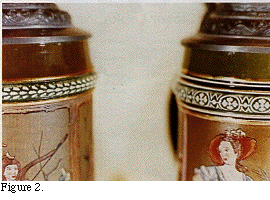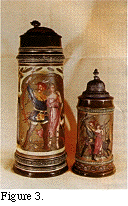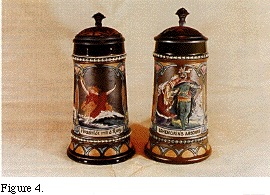Simon Peter Gerz I, GmbH
by Don Birschel

|
Stein Collectors International, Inc. |
|
Simon Peter Gerz I, GmbH by Don Birschel |
 |
|
Even though its advertising states that the company opened its doors in 1862,
the Simon Peter Gerz stoneware firm began operation in 1857. The first steins
produced at the factory were the well-known grey stoneware salt-glazed variety.
In fact Gerz still produces them today. Some time later they produced relief
steins in cream stoneware with tans, blues, greens, reds and full color
varieties. The most intriguing steins, however, were the etched steins Gerz
produced from the late 1890's through the early 1900's. |
|
 A
variation can also be found whereby the scenes are uncolored, appearing
cream-colored against the olive brown back-ground. Examples of both colored and
uncolored versions are found on stein numbers 262, 1210, 1215, 1217, 1254, 1318
and 1287, the latter of which is a tobacco jar. Most likely, many other steins
were produced in these varieties. Some steins, such as numbers 1477 and 1214B,
were also produced in the grey variety with no coloring whatsoever except for
the band near the rim. A
variation can also be found whereby the scenes are uncolored, appearing
cream-colored against the olive brown back-ground. Examples of both colored and
uncolored versions are found on stein numbers 262, 1210, 1215, 1217, 1254, 1318
and 1287, the latter of which is a tobacco jar. Most likely, many other steins
were produced in these varieties. Some steins, such as numbers 1477 and 1214B,
were also produced in the grey variety with no coloring whatsoever except for
the band near the rim.The color used on the bands seems to be consistent, being a pretty French green. l have discovered one stein, mold number 1254, which can be found with three varieties of bands. One style is horizontally ribbed with a 45 degree hatch through it. The second, and most often seen, is a type of a clover inside of an oval repeating pattern. The third is a repeating three-set beaded pattern Figure 2).  The
same scene can often be found on different size or shape steins. An example of
this can be seen on stein numbers 1217 and 1220. Number 1217 is a tall and thin
1/2 L stein, while the number 1220, 1/2 L, is a short and wider stein. Both
steins bear the same aforementioned scene. Stein number 1237A is a 3 L which is
narrow at the top and bulbous at the bottom, curving in at the foot. It is a
master stein to number 1237B, a 0.3 L stein of exactly the same shape. The
scene is one of ancient hunters, a man and woman. The same scene can be found on
stein number 1222A, a 3 L, (see figure 3) which has a standard shape and is a
master to 1222B, a 1/4 L stein. Stein number 1254, a 1/2 L, also has the same
scene; however it is not part of the set. The scenes differ slightly (figure 3)
in that the 1/2 L shows three hunting scenes while the 3 L has the same main
scene on the front of the stein, but game hanging on the side scenes. Note that
the dog is a different color on each stein. The
same scene can often be found on different size or shape steins. An example of
this can be seen on stein numbers 1217 and 1220. Number 1217 is a tall and thin
1/2 L stein, while the number 1220, 1/2 L, is a short and wider stein. Both
steins bear the same aforementioned scene. Stein number 1237A is a 3 L which is
narrow at the top and bulbous at the bottom, curving in at the foot. It is a
master stein to number 1237B, a 0.3 L stein of exactly the same shape. The
scene is one of ancient hunters, a man and woman. The same scene can be found on
stein number 1222A, a 3 L, (see figure 3) which has a standard shape and is a
master to 1222B, a 1/4 L stein. Stein number 1254, a 1/2 L, also has the same
scene; however it is not part of the set. The scenes differ slightly (figure 3)
in that the 1/2 L shows three hunting scenes while the 3 L has the same main
scene on the front of the stein, but game hanging on the side scenes. Note that
the dog is a different color on each stein.
Of interest are stein sets with related scenes and concurrent numbers such as
1419 through 1422, which depicts Wagner opera scenes such as "Lohengrin"
and "The Ring." A ewer, number 1425, goes with this group (see figures
4 & 5). 
 The inlaid lids found with Gerz steins are generic, that is, they depict flowers, hops and leaves, or art deco designs, none of which adds to the scenes found on the steins. The lids do seem to be consistent with the stein numbers however. Some of the same scenes can be found on Gerz etched and relief steins. Two
examples are relief number 390, commonly found, and etched number 1335, a rarely
found 1 L stein depicting Achilles, Minerva and Agamemnon from mythology. The
etched 1236 "Four Seasons" is more common than the relief number 239.
|